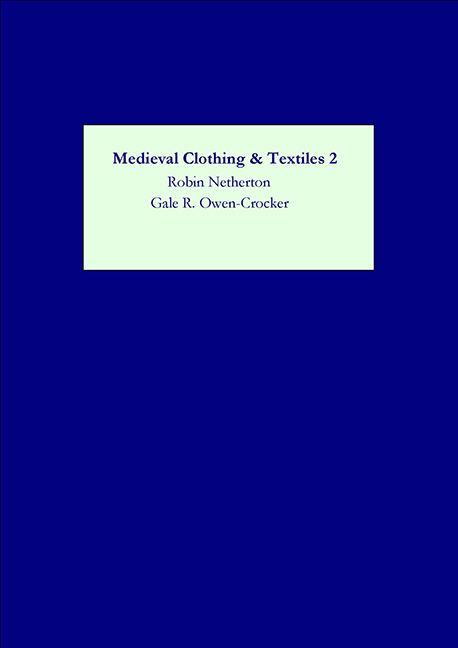Book contents
- Frontmatter
- Contents
- Illustrations page
- Tables
- Contributors
- Preface
- 1 Dress and Accessories in the Early Irish Tale 'The Wooing Of Becfhola”
- 2 The Embroidered Word: Text in the Bayeux Tapestry
- 3 “De Fil d'Or et de Soie”: Making Textiles in Twelfth-Century French Romance
- 4 Biffes, Tiretaines, and Aumonières: The Role of Paris in the International Textile Markets of the Thirteenth and Fourteenth Centuries
- 5 'Clothing Themselves in Acres”: Apparel and Impoverishment in Medieval and Early Modern England
- 6 'Ye Shall Have It Cleane”: Textile Cleaning Techniques in Renaissance Europe
- 7 Fleas, Fur, and Fashion: Zibellini as Luxury Accessories of the Renaissance
- 8 The Matron Goes to the Masque: The Dual Identity of the English Embroidered Jacket
- Recent Books of Interest
- Index
1 - Dress and Accessories in the Early Irish Tale 'The Wooing Of Becfhola”
Published online by Cambridge University Press: 14 February 2019
- Frontmatter
- Contents
- Illustrations page
- Tables
- Contributors
- Preface
- 1 Dress and Accessories in the Early Irish Tale 'The Wooing Of Becfhola”
- 2 The Embroidered Word: Text in the Bayeux Tapestry
- 3 “De Fil d'Or et de Soie”: Making Textiles in Twelfth-Century French Romance
- 4 Biffes, Tiretaines, and Aumonières: The Role of Paris in the International Textile Markets of the Thirteenth and Fourteenth Centuries
- 5 'Clothing Themselves in Acres”: Apparel and Impoverishment in Medieval and Early Modern England
- 6 'Ye Shall Have It Cleane”: Textile Cleaning Techniques in Renaissance Europe
- 7 Fleas, Fur, and Fashion: Zibellini as Luxury Accessories of the Renaissance
- 8 The Matron Goes to the Masque: The Dual Identity of the English Embroidered Jacket
- Recent Books of Interest
- Index
Summary
Ireland possesses one of the most extensive vernacular literatures in Europe, some stories going back at least to the seventh century. Heroic tales, especially, contain many descriptions of the dress and equipment of their aristocratic protagonists. The question of how seriously these should be taken as accurate depictions of ancient artefacts has been discussed by J. P. Mallory, in a study of the Ulster Cycle of Tales. The stories in this cycle purport to describe a distant past, and it has been famously claimed that they provide a “window on the Iron Age.” However, when the objects described in the sagas are compared with actual items which survive from the Irish Iron Age, they do not make a good fit. On the other hand, they often match finds dating to the early Middle Ages, either to the period immediately preceding the Viking settlement (sixth to ninth centuries) or to time when the Viking taste for silver strongly affected the Irish (mid-ninth to mid-tenth centuries). Mallory concluded that the material culture employed to flesh out the stories was more or less contemporary with the language in which the text was composed, rather than with the period in which the drama purports to take place.
In addition to those who are acknowledged elsewhere in this paper, I am grateful for generous help from the following: Breandán Ó Cíobháin, Edel Bhreathnach, Anne Connon, Barbara Hillers, Cormac Bourke, Dáibhí Ó Cróinín, Paul Mullarkey, and Raghnall Ó Floinn. I also thank the staff of the libraries of the Royal Irish Academy and of the Society of Antiquaries of London for producing many texts at short notice. Finally I thank Siobhán Cuffe and David Bennett for the skill and patience with which they drew the accompanying illustrations. A spoken version of this paper was presented in May 2004 at the International Congress on Medieval Studies at Kalamazoo, Michigan. I am grateful to the British Academy for funding my travel there. An article on the wider context of “The Wooing of Becfhola,” provisionally titled “Finery in Fact and Fiction,” will appear in a future volume of Peritia: Journal of the Medieval Academy of Ireland.
This paper examines references to clothing and accessories in a tale from the Cycle of the Kings, “The Wooing of Becfhola” (Tochmarc Becfhola), with a view to seeing if Mallory's findings hold good in this instance.
- Type
- Chapter
- Information
- Medieval Clothing and Textiles 2 , pp. 1 - 34Publisher: Boydell & BrewerPrint publication year: 2006
- 1
- Cited by



